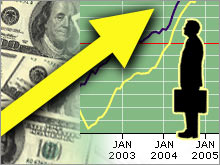Are bigger paychecks around the corner?
People on Main Street would cheer, but Wall Street and Fed are starting to worry about upward pressure on wages.
NEW YORK (CNNMoney.com) - All of a sudden one of the bigger worries for investors is what average workers have long been waiting for: bigger paychecks. This week brought several reports suggesting that wage growth is finally ready to accelerate.
Of course, those same reports fanned worries on Wall Street about rising labor costs that could dent corporate profits and lead to a pickup in inflation. The unemployment rate fell to 4.7 percent Friday, the lowest level since July 2001, just before the Sept. 11 terrorist attacks. That reading helped send stock futures down in pre-market trading. The same report showed the average hourly wage rose 7 cents in the month to $16.41, a 0.4 percent increase that was slightly more than forecast by economists. During the last 12 months, average wages are up 3.3 percent on a seasonally adjusted basis, the biggest 12-month change in nearly three years. Friday's report follows a number of other readings and surveys suggesting the balance could be tipping to employees from employers. On Tuesday, the Labor Department said wages and salaries jumped 0.8 percent in the fourth quarter, the biggest gain in its Employment Cost Index since 2002. And Thursday, a government report showed a surprise drop in worker productivity, the first in five years. Strong productivity growth in the 1990s through much of last year helped keep labor costs in check. Experts in the field say that in many regions and across many occupations, serious labor shortages are developing that are putting upward pressure on wages. "We conducted a survey of 600 hiring managers in January and found 70 percent said worker retention is a primary concern in 2006," said Steve Pogorzelski, president at online job search firm Monster.com. "The underlying reason for the concern is escalating wages, especially in occupations that have experienced strong demand." Pogorzelski, who saw his firm's Monster Employment Index of online hiring activity jump 4 percent in January, said a tight supply of job candidates is spreading beyond some of the skilled occupations that have been hot for more than a year, such as nursing and accounting. "We're also seeing strong pressure in transportation and warehousing. Accommodation and food services as well as office and administrative support are all in high demand," he said. Regionally, employers along the Gulf Coast are having a particularly tough time finding the workers they need in the wake of last year's hurricanes. Employers aren't the only ones nervously watching the direction of paychecks. "The Fed has intimated that it is concerned about tightness in some labor markets," said Jeoff Hall, managing economist at Thomson Financial. "More than half of industries and occupational categories are reporting tightness. "It's going from pockets of labor resource constraints to something closer to a tight national labor market," he added. Of course, that's good news for those hoping for fatter raises this year, especially with energy prices rising and wage increases not keeping up with inflation across much of the country. Other surveys show employees are already figuring out what the experts are seeing. A survey by Salary.com released this week found that 65 percent of U.S. workers said they are considering looking for a job. Bill Coleman, vice president for compensation at Salary.com, said that the job searching by current employees is forcing employers to be more generous with raises. "They know there is a larger trend than in recent years for people to leave," Coleman said. "They realize that in order to meet growth goals, they'll have to pay the people they want to keep as well as to hire the people they want to lure in." Coleman said that someone switching jobs can look for a 10 percent increase as part of the move. "Two or three years ago, 5 percent would have been on the high end," Coleman said. "There were a lot of people switching jobs for about the same pay or even taking less money. That was a result of inflated salaries from the late '90s." He added that even employees who find new hires being paid more for comparable work will benefit as employers adjust salary scales. The Conference Board's consumer confidence survey also found that those saying jobs are "plentiful" increased to 26.9 percent in January from 23.3 a month earlier, while those claiming jobs are "hard to get" fell to 20.3 percent from 22.5 percent. Experts like Pogorzelski and Lauren Williams, managing partner of the executive recruiting firm Princeton Search Group, say that it's probably too soon to expect big jumps in compensation across the board this year. But many workers could find more receptive bosses when pay raises are discussed. "There have not been drastic jumps (in wages) like we saw in the late '90s, but certainly there's a light at the end of the tunnel," Williams said. "I think we'll see that slow and steady continuous increase in wages in the 4 to 8 percent range." But without the large jumps in productivity seen in the 1990s, employers are more likely to look to pass along increased wage costs. And that could keep the Federal Reserve raising rates longer than current forecasts in an effort to slow the economy and keep inflation in check. "The bond market has been hit hard the last few days on these concerns," Hall said. That's why a very strong January jobs report could actually result in further declines in the stock markets, especially if the wage component of the report rises more than analysts are expecting. ________________
For more on the U.S. labor market and what it means for you, click here. |
| ||||||||||||||||||||||||||||||||

